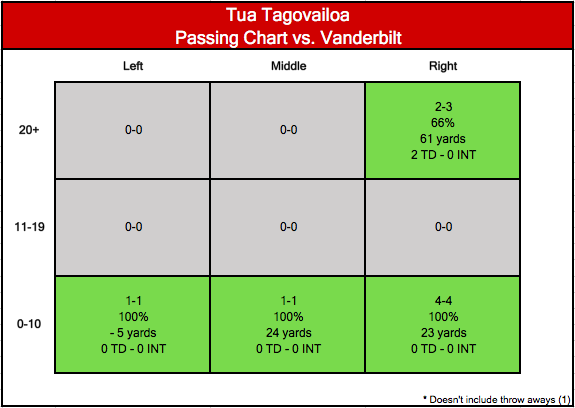
No, Tua Tagovailoa isn’t going to be Alabama’s starting quarterback anytime soon. Not as long as Jalen Hurts continues to play like he has been, which has been plenty good enough.
This isn’t a call for Nick Saban to start the freshman phenom, but this piece will display exactly what Tagovailoa would bring to the Alabama offense, should he be inserted into the lineup for any reason.
Tagovailoa entered the Vanderbilt game with 10:48 left in the third quarter, and offensive coordinator Brian Daboll had him slinging it around from his first play. Tagovailoa finished 8-for-10 for 103 yards and two touchdowns. In addition, he also ran once for 22 yards on a zone read.
Here’s a breakdown of Tagovailoa’s passing chart against the Commodores.

It was magnificent performance for the former 5-star. One that even earned the attention of Tennessee Titans star quarterback, and fellow native of Hawaii, Marcus Mariota.
It isn’t the first time, either.
Starting with the annual A-day game in April, Tagovailoa has been showing why he was the No. 1 dual-threat quarterback in the 2017 recruiting class.
Beautiful touch on this throw from #Alabama true freshman QB Tua Tagovailoa to WR TJ Simmons. pic.twitter.com/9PuBogoojZ
— Clint Lamb (@ClintRLamb) April 22, 2017
There are a couple of things that Tagovailoa brings to the Alabama offense that Hurts doesn’t, or at least he hasn’t to this point.
One of the first things you notice about Tagovailoa is how advanced he is at sensing pressure in the pocket, and how he is able to remain calm while using his feet to move within that pocket. Hurts does that too, but it frequently ends with him running.
Tagovailoa's first TD against Vanderbilt. pic.twitter.com/OjWIxBq15T
— Clint Lamb (@ClintRLamb) September 26, 2017
Right tackle Matt Womack lunges at the edge rusher, which allows the defender to create pressure from Tagovailoa’s blindside — notice how Womack is considered the blindside protector due to Tagovailoa being a left-handed quarterback. Tagovailoa senses the pressure, steps up in the pocket and delivers an accurate ball to Jerry Jeudy.
Tua hanging in the pocket during the A-Day game back in April. pic.twitter.com/EiLzlmM70P
— Clint Lamb (@ClintRLamb) September 26, 2017
Here, Tagovailoa does a nice job of keeping his head up despite the oncoming pressure from his left. He avoids being sacked with just a slight shuffle to his right, and while the throw may have been ill-advised, it’s just another example of Tagovailoa’s ability to create.
Speaking of his ability to create, that’s another positive aspect of Tagovailoa’s game. Not in the way that Hurts does with his legs, but with his arm. Here’s a perfect representation of that.
Tagovailoa's ability to create in the passing game is spectacular. pic.twitter.com/vhHXEqqfk7
— Clint Lamb (@ClintRLamb) September 26, 2017
You can see that he doesn’t panic. He remains calm and despite all that’s going on around him, he’s still thinking “pass first,” which allows him to throw a beautiful touchdown pass to fellow freshman DeVonta Smith.
As tough as this is to admit, I don’t see Hurts making that sort of play. More than likely, he would’ve already decided to tuck it and run. That’s not necessarily a bad thing, as it allows Hurts to keep mistakes to a minimum, but it does diminish his ceiling as a passing quarterback.
Another dynamic that Tagovailoa would bring is his ability to consistently deliver the ball downfield. It’s not that Hurts is incapable of that. In fact, he’s improved since last season. It’s that Tagovailoa can create more passing plays of 15-plus yards because of his “pass first” mentality.
Alabama QBs on throws 15+ yds downfield:
Hurts: 4-15
Tagovailoa: 3-4— CFB Film Room (@CFBFilmRoom) September 26, 2017
Defenses know that Hurts is a run-first quarterback, and while he is still effective as a runner, that can hurt him.
Opposing defenses only need to cover their man or zone for a couple of seconds because they know if the primary read isn’t there, Hurts will more than likely become a runner. That creates a situation where it makes the defensive back’s job easier, and that’s never a good thing.
The bottom line is that Alabama has proven it can win with Hurts, and it’s going to stick with him unless he starts becoming a liability, which I wouldn’t count on at this point. There are things that Hurts does as well as anyone in the country, but he isn’t a quarterback without weaknesses.
That’s not to say that Tagovailoa doesn’t have weaknesses, and there is the very real possibility that his youth could hurt Alabama at some point if he were to eventually become the starter this season.
We only have so much to go on, but so far, Tagovailoa has proven that he is only a freshman academically.
Clint helps cover the SEC West for Saturday Down South. His work can also be found on USA TODAY Sports, The 'Bama Beat podcast and The Bullpen with TonyMac and The Lamb. Previous stops include SEC Country, 247Sports and Touchdown Alabama Magazine.







